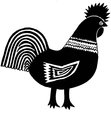
This is the third and final post on acids and bases, and natural pH indicators. I hope that it has been helpful and informative and leads to interest in the area of natural pH indicators. This entry is on Turmeric, an Indian spice that has been used as a dye for over 2000 years. Sometimes spelled tumeric, it contains curcumin, a polyphenol, that reacts with boron under specific conditions, to form a dye called rosocyanine. This test has been in use for about 100 years and the complex formed between the yellow curcumin and the element boron forms the rosocyanine which is a green crystal. The test as performed now is done spectrophometrically at 540 nm. So, the demonstration used as a visual determination is qualitative and not quantitative. Following the video will be a writeup and an explanation of what I have discovered as a result of my investigation that is somewhat different than material presented elsewhere. So, let's get to the video and the art deco chicken!
CAUTION- The yellow color strength of the turmeric in alcohol is very strong and will stain any porous surface. I am still trying to clean up some of the mess!
Materials needed:
Turmeric- Available as a spice in most supermarkets. The tincture is made by adding 1 gram to 100 ml of 70% ethyl rubbing alcohol. (Drug store).
Filter paper- But coffee filter paper will work as well.
Sodium Hydroxide- Sold as lye at hardware stores. Make a 0.1 N solution with 4 grams made up to 1 liter of distilled water.
Hydrochloric acid- Sold as muriatic acid 28% HCl (Hardware store). Make a 0.1 N solution with 17 ml made up to 1 liter.
Boric acid- Sold as ant and roach powder at garden centers and hardware stores. Make a 2% solution with distilled water.
Procedure:
Dip the filter paper into the tincture of turmeric and let dry. Then, dip that paper into the 0.1 N HCl and let that dry. Now, dip that paper into the boric acid let that dry. The test paper is then dipped into the 0.1 N NaOH solution. A black to green-black color indicates the presence of elemental boron. You can test for boron in soil by taking 100 grams of soil and adding 100 ml of distilled water. Shake well and let sit overnight. Decant off the water and test. But remember that this test is strictly for the presence of boron, not the amount. For the art deco chicken, I coated the tincture onto some inkjet photo paper with a foam brush and let dry. Exposed through the positive image for 24 hours. Then, dipped in the HCl, dried, dipped in the boric acid, dried, and then in the 0.1 N NaOH as in the video. There is still some work to do on the imaging potential. For example, a base coat to keep the yellow on the surface and finding an additive that will make the curcumin even more sensitive to light. So much to do and so little time!
Some closing thoughts...
I have posted this entry in good faith and my investigation suggests that there is some incorrect information regarding the dye formed on several sites. In no way do I believe that any information that I have found on the web is intentionally misleading, but rather, that the chemistry is fairly complex. Although I have a background in chemistry, my lab is in my kitchen. Like many others, I don't have sophisticated equipment, and I buy my chemicals at garden centers, hardware stores, and other local places. And as others do, I make mistakes! If you can add to the discussion and shed more light on the subject, please comment. Hey, we are all in this together...Ken.
 RSS Feed
RSS Feed
